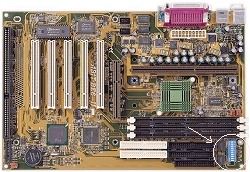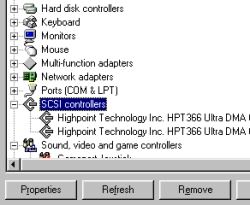| Abit BE6-2 Review
by Tim "Flyboy" Henderson |
||||
|
In the spring of 1999 Abit released the successor to their very successful BX6 rev2 mainboard. The BE6 added ATA 66 support, but not much else, to an already feature rich product. Recently Abit released the BE6-II. The BE6-II adds additional bus speeds, in fact allowing micro adjustment of any speed beyond 83 MHz. Naturally, the mainboard already supports ATA66, and is possibly the best mainboard on the market for gamers who like to tweak their system for maximum performance. Let's take it around the block and see how it shines! The Full Meal Deal The BE6-II arrives with a written manual, floppy & IDE cables as well as one of the new expensive UDMA/66 cables .. and a thermal sensor! Abit also includes a CD-ROM with a batch of utilities, and the manuals for all their mainboards in PDF format. Some manufacturers now include their mainboard manuals in digital format only, but Abit has provided both; a welcome touch! Layout of the board is clean, in typical Abit fashion. Some might be surprised to learn that there are three DIMM sockets on the BE6-II rather than four. The BX6 2.0 offered four DIMM's for up to 1GB of SDRAM. For the BE6 Abit removed the six chip data buffer which is necessary for 4 DIMM sockets to operate reliably. This will only matter for you if you need to mount more than 768MB SDRAM. If you've checked out the BE6-II previously, then you know that there are 120 bus speeds available to choose from. Only Abit offers this much flexibility; no other product on the market offers as many bus speed choices. Like the BF-6, Abit places the DIP switches at the top of the motherboard. This is not a good position since access is tricky once the mainboard is installed. But since Soft Menu III allows complete adjustment of CPU settings in the BIOS, this isn't a problem. On the plus side, Abit's use of DIP switches rather than jumpers shows their intention to take the high road. Jumpers are a ROYAL PAIN to set once the board is mounted inside a case. Unlike the BF-6, the BE6-II only has five PCI slots. The addition of the HighPoint ATA-66 controller required removal of one of the PCI slots to prevent IRQ conflicts. For power users and overclocking fans, Abit included three fan headers. Two of the headers are located between the DIMM sockets and the Slot 1 interface, and another is fitted near the battery at the bottom of the motherboard. |
 Notice the Bus Speed Jumpers ATA-66 Standard The ATA-66 interface has resulted in a second generation of drives with 7200 RPM spindle speeds. Some of the newer drives sport 2MB buffers, and they can be found affordably up to 27 GB and in sizes exceeding 40GB. The BE6-II sports FOUR IDE connectors. While this isn't significant for the average user, one could install up to eight drives, even mixing ATA33 and ATA66 drives. While ATA66 drives are backwards compatible with ATA33, ATA66 use requires an 80-conductor cable. A single 80-conductor cable is included with the mainboard, in addition to the traditional 40-conductor cable.
 HighPoint and SoftMenu III Once you've got everything set up in hardware, it's time to install the software. Windows 98 immediately recognizes the HighPoint controller as a "Mass Storage Controller." When prompted, you insert the CD which includes the HighPoint ATA66 drivers. WIN98 will promptly identify the controller as a SCSI device. Odd, but it works! With each new revision, Abit adds more features to their SoftMenu system. The flexibility of this BIOS based interface is somewhat legendary. You can adjust CPU voltage, disable CPU detection error messages, and generally make any CPU dance and sing with a few easy adjustments. Go to Page Two |
|||
|
Copyright © 1997 - 2000 COMBATSIM.COM, INC. All Rights Reserved. Last Updated January 10th, 2000 |
||||

